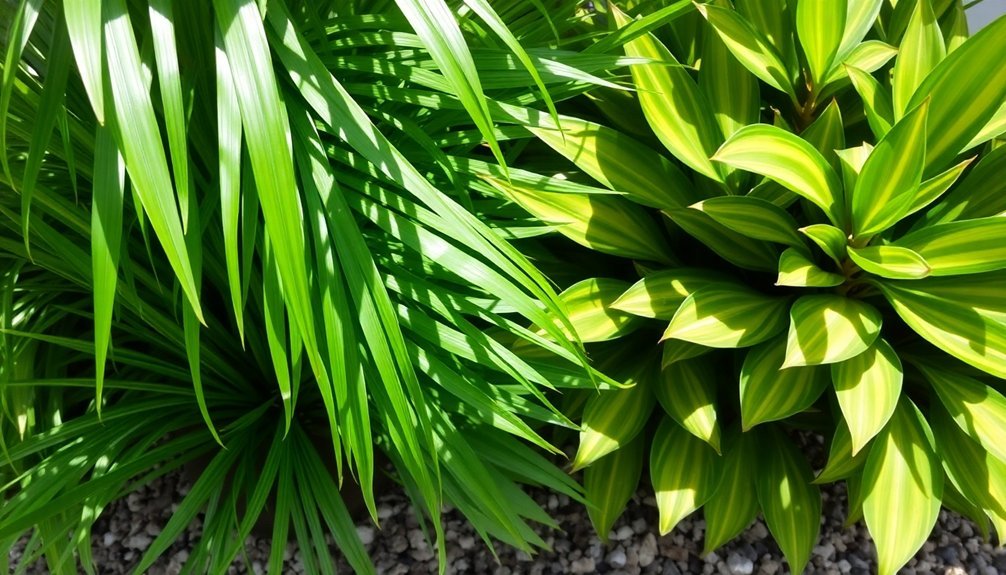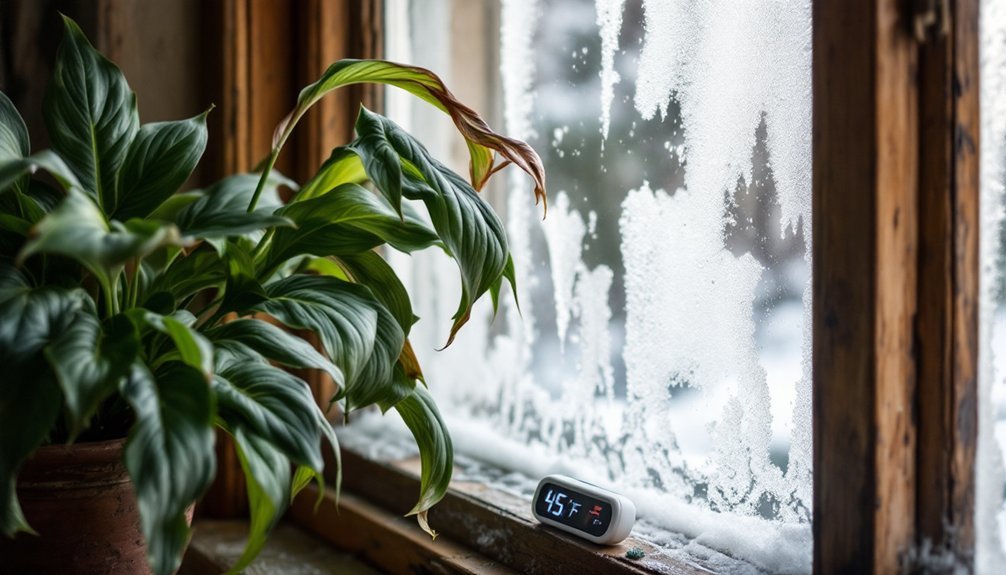Seven plants pair beautifully with your bamboo palm while sharing similar care needs and enhancing air purification. Peace lilies offer glossy contrast to feathery fronds, while snake plants thrive alongside in low light. Spider plants and pothos add cascading elements, as Boston ferns boost humidity naturally. Chinese evergreens and dracaenas complete the mix with varied leaf patterns. These strategic pairings won't just simplify your plant care – they'll transform your space into a thriving indoor oasis.
Peace Lily Synergy Effects

When looking to create a harmonious indoor garden, peace lilies and bamboo palms make exceptional partners due to their complementary needs and benefits.
You'll find that these plants share similar preferences for light and humidity, making them perfect companions in your tropical-inspired space.
Your peace lily will thrive alongside bamboo palms, as both plants work together to purify indoor air and create a healthier environment.
While they both enjoy moist soil conditions, the peace lily's tolerance for occasional dry spells offers you more flexibility in watering routines.
The striking contrast between the peace lily's glossy leaves and white flowers beautifully complements the bamboo palm's delicate fronds.
Place them in areas with indirect sunlight, and you'll create an eye-catching display that's both aesthetically pleasing and environmentally beneficial.
Snake Plant Companion Benefits
Another excellent companion for your bamboo palm is the snake plant, offering a powerful duo for improving indoor air quality. Together, they'll create a formidable air-purifying team while sharing similar care requirements.
You'll find that these plants complement each other perfectly in low-light areas of your home, making them ideal roommates.
- Snake plants filter out harmful toxins like formaldehyde and benzene, enhancing the air-cleaning properties of your bamboo palm.
- Both plants thrive in similar lighting conditions, eliminating competition for prime spots.
- Their contrasting shapes create stunning visual interest, with the snake plant's rigid, upright leaves perfectly balancing the bamboo palm's graceful fronds.
- The paired maintenance needs make care simple, as both plants are forgiving and can handle occasional neglect.
Pothos Pairing Advantages

Pairing pothos with your bamboo palm creates an effortless yet striking combination that'll transform any indoor space.
These complementary plants share similar light preferences, thriving together in low to moderate light conditions while requiring minimal care.
You'll appreciate how pothos' trailing vines create a beautiful layered effect beneath your bamboo palm's tall, graceful fronds. This natural arrangement adds depth and visual interest to your room without any complicated styling.
The duo works together to purify your indoor air, filtering out harmful toxins more effectively than either plant alone.
What's more, pothos' adaptability to varying humidity levels means you won't need to worry about maintaining specific moisture conditions – it'll happily grow alongside your bamboo palm with basic care, making this pairing perfect for busy plant parents.
Spider Plant Air-Cleaning Duo
Spider plants stand out as ideal companions for bamboo palms, combining their air-purifying powers to create a natural filtration system in your home. Together, they'll effectively remove harmful pollutants like formaldehyde and xylene, ensuring cleaner air throughout your space.
You'll find these plants make perfect partners because they share similar care requirements:
- Both thrive in well-drained soil and consistent watering schedules
- They adapt well to various light conditions, from low to bright indirect light
- Their contrasting foliage creates an eye-catching display
- They maintain peak performance in the same humidity levels
The spider plant requires slightly less water than your bamboo palm, but don't let this minor difference concern you.
Their complementary growth patterns and shared environmental preferences make them an excellent choice for creating a healthy, visually appealing indoor garden.
Boston Fern Humidity Harmony

When you're looking to maximize humidity for your bamboo palm, Boston ferns make perfect companions as they naturally maintain moisture levels through transpiration.
You'll find these two plants work beautifully together in shaded spots, as both thrive in indirect light conditions without competing for resources.
Moisture Levels Matter Most
Creating a harmonious moisture balance in your indoor garden becomes effortless by matching bamboo palms with Boston ferns.
These plants work together to maintain optimal moisture levels through their shared love of humidity and consistently damp soil. You'll notice they create their own microclimate, reducing your watering responsibilities while maximizing each plant's growth potential.
Key benefits of this moisture-conscious pairing include:
- Natural humidity regulation through the fern's transpiration process
- Reduced watering frequency due to their collaborative moisture retention
- Consistent soil moisture maintenance that benefits both species
- Enhanced visual appeal from the combination of feathery fern fronds and elegant palm leaves
This dynamic duo's ability to work together makes them a perfect choice for indoor gardeners looking to maintain proper moisture levels with minimal effort.
Natural Shade Partners Together
Beyond moisture compatibility, the Boston fern stands out as a natural companion to your bamboo palm in shaded spaces. You'll find these plants work together perfectly in low-light areas, creating a lush tropical atmosphere while improving your indoor air quality.
| Feature | Benefits |
|---|---|
| Light Needs | Both thrive in indirect light |
| Air Quality | Combined filtering power |
| Visual Appeal | Contrasting textures blend |
The feathery fronds of your Boston fern create an eye-catching contrast against the structured leaves of the bamboo palm. Together, they'll form a stunning display that doesn't compete for resources. When you're planning your indoor garden, consider this dynamic duo for areas that don't receive direct sunlight. Their shared preference for humid conditions means they'll support each other's growth while maintaining a consistently tropical environment.
Creating Tropical Indoor Zones
To establish a thriving tropical zone indoors, pair your bamboo palm with Boston ferns to create a self-sustaining humidity ecosystem.
These plants work together perfectly, as Boston ferns naturally release moisture into the air, benefiting both species. You'll notice their complementary appearances enhance your space's tropical feel, with the ferns' delicate fronds contrasting beautifully against the bamboo palm's broader leaves.
- Both plants thrive in similar light conditions, preferring indirect sunlight
- They share comparable care requirements, making maintenance simple and efficient
- Together, they create a natural air-purifying system for your home
- The combination helps maintain ideal humidity levels without additional humidifiers
Chinese Evergreen Growth Match

When searching for an ideal companion to your Bamboo Palm, Chinese Evergreen stands out as a natural match due to their harmonious growing requirements.
You'll find that both plants thrive in similar lighting conditions, making them perfect partners in shaded corners or rooms with indirect sunlight.
You can maintain these plants together effortlessly since they share similar care needs. Keep the soil consistently moist for both species, but don't overwater them.
You'll appreciate how these plants work together to purify your indoor air while creating a visually striking display. The Chinese Evergreen's varied leaf patterns and colors provide beautiful contrast against your Bamboo Palm's green fronds.
Place this dynamic duo in humid spaces like your bathroom or kitchen, where they'll flourish and enhance the tropical atmosphere you're creating.
Dracaena Space Optimization
Since dracaena plants naturally complement bamboo palms in height and structure, they create an ideal vertical gardening solution for your space.
These towering companions can reach up to 6 feet, making them perfect for maximizing your room's vertical potential while providing a stunning backdrop for shorter bamboo palms.
- Position taller dracaena varieties behind bamboo palms to create a layered, forest-like appearance
- Mix different dracaena leaf patterns and colors with bamboo palm's feathery fronds for visual interest
- Group plants with similar light requirements to simplify care routines
- Take advantage of shared watering schedules to maintain both species efficiently
The combination of these plants not only optimizes your space but also doubles the air-purifying benefits, creating a healthier indoor environment that's both visually appealing and functional.
Frequently Asked Questions
What Plants Look Good Next to Bamboo?
You'll find Southern Magnolia, Clematis, Hoya, Sour Grapes, and Fatsia make excellent companions for bamboo. They'll complement its foliage while offering varied textures, colors, and heights to your garden arrangement.
What Pairs Well With Bamboo?
You'll find Southern Magnolia, Clematis, and Hoya make excellent companions for bamboo. They thrive in similar conditions and create stunning visual combinations. Bird of Paradise and Fatsia also work beautifully in shaded areas.
What Plants Pair Well With Palm Trees?
You'll find that ferns, flowering vines like clematis, and tropical plants like bromeliads pair beautifully with palm trees. Ground covers such as creeping thyme and colorful additions like azaleas create stunning combinations.
What Are the Cons of Bamboo Palms?
You'll face several challenges with bamboo palms: they're prone to spider mites and scale insects, grow very slowly, can develop root rot from overwatering, and need high humidity. They're also sensitive to salt buildup.
In Summary
You'll find these seven bamboo palm pairings transform your indoor garden into a thriving ecosystem. Whether you're combining it with peace lilies for enhanced air purification, snake plants for low-maintenance beauty, or any of the other suggested plants, you're creating an ideal growing environment. Try mixing and matching these companions to discover what works best in your space while maximizing the benefits of each pairing.





Leave a Reply